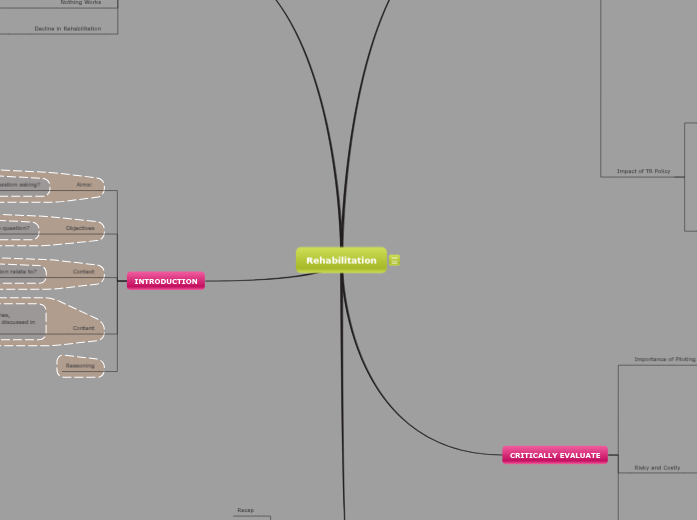door Gillian Dickinson 8 jaren geleden
1450
Question 2: Rehabilitation and Transforming Rehabilitation

door Gillian Dickinson 8 jaren geleden
1450

Meer zoals dit
The question covers a number of central concerns. These are:
The use of rehabilitation within the administration of punishment both historically and contemporarily
The purpose of punishment that is rehabilitation
The difference between a constructive and deconstructive criminal justice system
Analysis and evaluation of the use of rehabilitative treatments within current examples of punishment
Prevent people going into prison for short periods, with all the inevitable disruption and harm it causes to them and their families.
People coming out of prison often need help and support to: find accommodation; secure benefits to which they are entitled; find a job; enrol in education; access health services,
According to Transforming Rehabilitation what is needed is: 'a system where one provider has overall responsibility for getting to grips with an offender's life management skills, coordinating a package of support to deliver better results.' There was such a system already in place. The Probation Service was directly responsible for the supervision of the vast majority of individuals serving sentences in the community. It also undertook the supervision of those who received prison sentences of more than 12 months.
Pilots should have ran for 6-7 years
Yet, there are many examples of PbR schemes where implementation has been rushed, with very few being piloted or phased in advance of full roll-out.
Some of the new services proposed in the bids for contracts had not been implemented
None of the prisoners in their sample (86 cases) had been helped into employment by Through the Gate services
Too many prisoners reached their release date without their immediate resettlement needs having been met or even recognised.
Inspectors found that overall, services were poor and there was little to commend.
There was a lack of Through-the-Gate support
There was a lack of compliance to complete unpaid work.
less rehabilitative work was being done under new probation system.
CRC’s need to pay more attention to the quality of work they are delivering.
HMP Leeds
MoJ tendered contracts for a pilot offender rehabilitation programme but closed the competition without a successful bid after all but 1 of the 6 potential providers decided not to compete.
This was despite MoJ taking steps, before tendering, to understand providers’ appetite for risk in taking on a PbR contract, including engaging in a process of competitive dialogue with potential bidders.
The firms reported that the model for the pilot was unworkable.
- HMP Peterborough
- HMP Doncaster
Completion of these initial pilots could have revealed the areas of contention and concern we are now seeing, before the national roll-out.
The MoJ undertook the pilots to inform later decisions about a possible nationwide scheme yet they decided to roll the scheme out nationally before the pilots’ results were fully known.
Payment only for achieving demonstrable results, with clawback available for underperforming and higher payments for further improvements over minimum requirement
Large financial deductions / termination for increase in re-offending rates
Basis for PbR requires CRC's to:
Deliver other interventions
Deliver an Accredited Programme
Deliver an Unpaid Work Requirement
Deliver a Supervision Requirement
Manage the sentence for a Community Order and Suspended Sentence Order
'Payment by Results'
Breaking the Cycle (2010): defining how we will pay providers for rehabilitating offenders- these will manage 236,000 low and medium risk offenders.
Offender Rehabilitation Act 2014 (ORA): After coming into force on 1 February 2015. The most significant change under the ORA is to extend statutory supervision after release to the 45,000 offenders a year who are released from short prison sentences of less than 12 months.
Before the changes, this group receive no statutory supervision after they are released. Despite the fact that this group of offenders have the highest reoffending rates of any group:
Almost 60% of adult offenders released from short prison sentences in the year to March 2013 went on to reoffend within the next 12 months: a total of 16,719 re-offenders committing 85,047 further offences.
Effectiveness of rehabilitation in reducing recidivism
A range of studies show that rehabilitative programmes can only be effective if the prisoner wants to participate.
McNeill (2006: 46), for instance, explains this ‘desistance paradigm’ thus: ‘Put simply, the implication is that offender management services need to think of themselves less as providers of correctional treatment (that belongs to the expert) and more as supporters of desistance processes (that belong to the desister).’
Likewise, Porporino (2010: 80) writes: ‘The desistance paradigm suggests that we might be better off if we allowed offenders to guide us instead, listened to what they think might best fit their individual struggles out of crime, rather than continue to insist that our solutions are their salvation.’